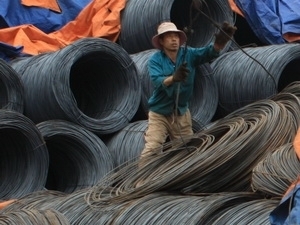Steel industry sees low May consumption
 Specifically, the production volume of construction steel in May alone reached 410,000 tones, a reduction of 50,000 tonnes against April.
Specifically, the production volume of construction steel in May alone reached 410,000 tones, a reduction of 50,000 tonnes against April.
In the first five months this year, steel production reached nearly two million tonnes or a decrease of 198,000 tonnes over the same period last year. Also in May, stockpiled volumes stood at 320,000 tonnes, or up 65,000 tonnes against April.
Steel consumption is estimated to have reached 370,000 tonnes last month or a decrease of 73,000 tonnes against the previous month.
The ministry reports that steel production companies have to moderate their production to minimise stockpiled steel volumes. It said the import of steel ingots also dropped due to stockpiled volumes.
In the first five months, the import of pig iron is estimated to have hit 168,000 tonnes worth $108 million, a 67 per cent decrease in volume and 67 per cent in value over the same period last year.
Due to sluggish steel consumption, local steel manufacturers have had to slash their selling price between VND100,000 to VND150,000 per tonne, attributed to a finance shortage amongst property developers.
It is predicted that in the next months, steel prices will not increase much. However, steel consumption may see positive results thanks to further interest rate cuts and a VND29 trillion ($1.3 billion) finance package aimed to reschedule business tax.
A representative of a steel company said the most difficult thing facing the steel industry is low consumption and not the rising and declining price of raw material. However, the real estate sector is always a key consumption partner of the steel industry that has been given easier loan access thanks to the Government's loosened credit policy, which has had little impact.
Nguyen Tien Nghi, vice chairman of the Vietnam Steel Association, said in the time to come the steel industry will continue facing negative effects of the global downturn and weak local economy.
The local steel industry will continue to see difficulties as Government Resolution 11, aimed to curb inflation and stabilise the marco-economy, remains effective.
The association is determined to minimise production costs to create competitiveness and will offer reasonable prices and spur exports in order to reduce pressure on local consumption, Nghi said.
According to the steel association, to enhance local steel consumption, an increase in public spending is the most important issue to be addressed by steel producers. By doing so, they may have an opportunity to sell their unsold steel to get back investment capital and pay off debts.
What the stars mean:
★ Poor ★ ★ Promising ★★★ Good ★★★★ Very good ★★★★★ Exceptional
Related Contents
Latest News
More News
- Global partnerships key to Vietnam’s IFC development (December 26, 2025 | 16:18)
- Vingroup pulls out of bid to invest in North-South high-speed railway (December 26, 2025 | 11:42)
- Strengthening supply chains through trade promotions and customs reform (December 24, 2025 | 14:00)
- PM orders investment model for North–South high-speed rail (December 22, 2025 | 17:43)
- LS Eco Energy to invest in Vietnam rare earth sector (December 22, 2025 | 17:31)
- Government moves to establish International Financial Centre (December 21, 2025 | 21:00)
- Vietnam's IFC to target global investment flows (December 21, 2025 | 18:00)
- Two national hospitals expand capacity with new facilities (December 20, 2025 | 09:00)
- Ha Tinh breaks ground on major Vingroup industrial and energy projects (December 19, 2025 | 18:24)
- EVN launches major power infrastructure projects nationwide (December 19, 2025 | 18:17)

 Tag:
Tag:





















 Mobile Version
Mobile Version